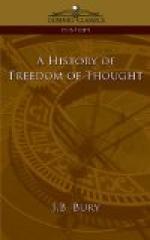[86] interested himself personally in such matters, Bartholomew Legate was charged with holding various pestilent opinions. The king summoned him to his presence and asked him whether he did not pray daily to Jesus Christ. Legate replied he had prayed to Christ in the days of his ignorance, but not for the last seven years. “Away, base fellow,” said James, spurning him with his foot, “it shall never be said that one stayeth in my palace that hath never prayed to our Saviour for seven years together.” Legate, having been imprisoned for some time in Newgate, was declared an incorrigible heretic and burned at Smithfield (1611). Just a month later, one Wightman was burned at Lichfield, by the Bishop of Coventry, for heterodox doctrines. It is possible that public opinion was shocked by these two burnings. They were the last cases in England of death for unbelief. Puritan intolerance, indeed, passed an ordinance in 1648, by which all who denied the Trinity, Christ’s divinity, the inspiration of Scripture, or a future state, were liable to death, and persons guilty of other heresies, to imprisonment. But this did not lead to any executions.
The Renaissance age saw the first signs of the beginning of modern science, but the mediaeval prejudices against the investigation
[87] of nature were not dissipated till the seventeenth century, and in Italy they continued to a much later period. The history of modern astronomy begins in 1543, with the publication of the work of Copernicus revealing the truth about the motions of the earth. The appearance of this work is important in the history of free thought, because it raised a clear and definite issue between science and Scripture; and Osiander, who edited it (Copernicus was dying), forseeing the outcry it would raise, stated untruly in the preface that the earth’s motion was put forward only as a hypothesis. The theory was denounced by Catholics and Reformers, and it did not convince some men (e.g. Bacon) who were not influenced by theological prejudice. The observations of the Italian astronomer Galileo de’ Galilei demonstrated the Copernican theory




